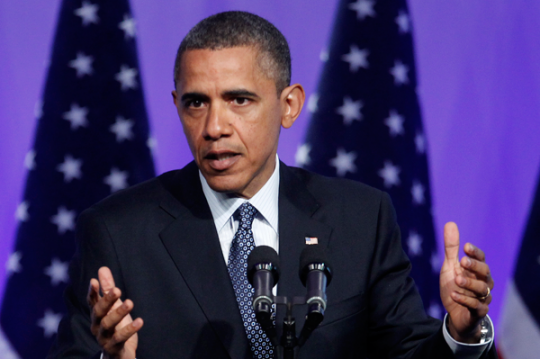President Obama appears to be using questionable math to bolster his attack on the House GOP budget.
One passage from the president’s April 3 speech at the Associated Press luncheon in Washington, D.C., which he has repeated several times this week, contains some dubious assertions but has yet to receive any public scrutiny.
Obama contends that the GOP budget, authored by Rep. Paul Ryan (R., Wis.), would provide "an average tax cut of at least $150,000 for every millionaire in America."
It is unclear how the president arrived at that figure.
Washington Post financial analyst and social science expert Ezra Klein admitted he was "not sure where Obama’s $150,000 is coming from."
Klein’s best guess, he wrote, was that the figure was gleaned from this table included in the Tax Policy Center’s (TPC) analysis of the Ryan budget, which estimates that the top one percent of income earners would receive an average tax cut of $156,000 in the year 2015.
However, the TPC analysis contains at least one glaring flaw. As made explicit in the title of the table Klein referenced, the TPC figures were calculated "without unspecified base broadeners."
That means TPC based its estimates solely on Ryan’s proposal to reduce tax rates for all Americans, while ignoring his proposals to raise revenue through tax reform and the elimination of tax loopholes commonly exploited by the wealthy.
The TPC table even comes with a bold disclaimer:
THE TABLE DOES NOT ESTIMATE THE DISTRIBUTIONAL EFFECTS OF THE ENTIRE FY 2013 BUDGET RESOLUTION PROPOSED BY REP. PAUL RYAN (R-WI). THE PROPOSED RESOLUTION INCLUDES MEASURES TO BROADEN THE INDIVIDUAL AND CORPORATE TAX BASES BUT LACKS SUFFICIENT DETAIL FOR AN ESTIMATE INCLUDING THOSE PROVISIONS.
Ryan has argued it is not his job as budget chairman to provide specific recommendations for tax reform because it is typically the purview of the House Ways and Means Committee. While technically correct, some conservative commentators have criticized Ryan for not being more specific in this area.
One Republican aide told the Washington Free Beacon that the White House’s basing its critique of the Ryan budget on an incomplete analysis would be "incredibly dishonest."
Glenn Kessler, the Washington Post’s resident fact-checker, relayed a slightly different explanation from the Obama administration as to how they arrived at the $150,000 figure.
In his dissection of Obama’s claim that every millionaire would receive an average tax break of at least $150,000, Kessler wrote:
[T]his $150,000 figure (for people with income of more than $1 million) comes just from the impact of making the George W. Bush tax cuts permanent ($105,000) and repealing Obama’s health care law ($46,000 in Medicare and other taxes). A senior administration official said Obama was assuming that the House Republican tax plan would not cut taxes more for the wealthy, though by White House calculations even eliminating every possible tax break for the wealthy, the lower rate would still result in an additional $107,000 tax break for the wealthy.
Kessler, however, did not provide any independent analysis in an effort to verify the claim. He told the Free Beacon via email that the administration official "spent a long time on the phone with me explaining how they reached those statistics," but pressure from his editors for copy prevented him from conducting a more thorough review.
Yuval Levin, a fellow at the Ethics and Public Policy Center, suggested the White House argument was indicative of the president’s commitment to higher taxes.
"So their claim is that keeping tax rates where they are now would amount to a $105,000 tax cut for millionaires, and that not putting into effect a new $46,000 tax increase would actually be a $46,000 tax cut?" he wrote in an email to the Free Beacon. "It seems to me the White House is admitting that they propose a $150,000 tax increase on every one of those Americans and that the Ryan budget would keep their taxes where they are."
Obama uses that $150,000 figure in his speeches in order to highlight what he claims is the Republican effort to "impose a radical vision" on the country by slashing federal spending (though Ryan’s budget merely slows the growth of spending) to "pay for" tax cuts for rich people.
That $150,000, the president has claimed, could pay for all of the following:
- One year’s salary for a firefighter or police officer.
- One year of prescription drug coverage for a senior citizen.
- One year of financial aid for a college student.
- One year of medical care for a military veteran.
- One tax credit for college tuition.
- A new school computer lab.
- A research grant for a chronic disease.
It is technically possible for Obama to make this claim accurately, given the vagueness of the list, according to a Free Beacon analysis. Federal data exist for items 1-5, which add up to less than $100,000. Determining the cost of items 6 and 7 is more complicated.
The Free Beacon found a number of budget estimates for school computer lab construction ranging from under $6,500 to as much as $44,000.
The National Institutes of Health maintains a thorough database of all awards for research grants for chronic diseases. For a chronic disease such as asthma, last year’s grants ranged from a high of $7.8 million to as little as $10. The median grant for asthma research was $323,000. The median grant for brain cancer research was $305,000.
